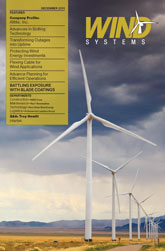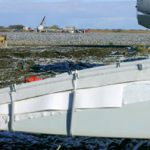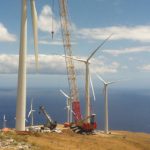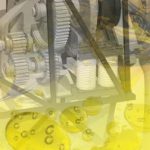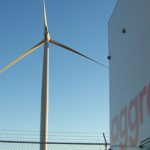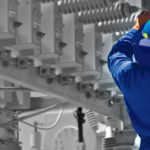Converting wind energy to electrical power is the fastest growing segment of the U.S. energy sector. Bolstered by available federal stimulus dollars there has been a virtual modern-day “land-rush” to develop wind farms. In the words of one industry leader, “If there is a site that has a viable wind profile, access to network connections, and access for delivery of materials and we don’t develop it, someone else will.”
This headlong rush to install more and more wind turbines has outstripped the usual developmental learning curve, in which new technologies mature by a process of trial and error, resulting in defining equipment that is suited for the job at hand. In this 21st century land rush, developers are often trading low initial costs for higher total costs of ownership to be shouldered later by the wind farm owners and operators. Nowhere is this more evident than with wind turbine generator (WTG) step-up transformers.
Historically the WTG transformer function has been handled by conventional, off the shelf distribution transformers. However, the relatively large numbers of recent failures has convinced many that WTG transformer designs must be substantially more robust. In fact, using conventional distribution transformers as a low cost solution is folly. In some cases site operators are even keeping a quantity of spare transformers at their wind farms so they have spares on hand for the frequent outages caused by using standard distribution transformers where they simply do not belong. What a waste of capital!
The key WTG step-up transformer design issues that wind farm owners and developers should pay attention to include transformer loading, harmonics and non-sinusoidal loads, transformer sizing and voltage variation, and special requirements to withstand faults. The role of the WTG step-up transformer is critical, and its design must be carefully and thoughtfully analyzed and reevaluated. We need to move from equipment purchasing decisions based on lowest initial cost to solutions that will provide the best choice in terms of total cost of ownership, network stability, less downtime, and lost revenue from high maintenance issues. New transformer technology specially designed for the wind farm market should be considered carefully when making purchasing decisions.
Transformer Loading
Wind turbines are highly dependant upon local wind and other climatic conditions, and their yearly average load factors can be as low as 35 percent. Most utilities in the past anticipated that operational loading would be about 50 percent. The relatively light loading of the WTG transformer introduces two unique and functionally significant problems that must be incorporated into WTG design.
The first issue is that the wind farm transformers’ relatively low average load factors skew purchasing decisions and make older economic models inaccurate. When lightly loaded or idle the core losses become a more significant economic factor, while the coil or winding losses become less significant.
Previous purchasing decisions included an estimate of the transformer’s amount of idle time. The overall evaluation looks at how much of the time the transformer is sitting idle and how much it will be running, and compares the ratio of these two. Those looking to apply this mode to wind farms must be much more cognizant of idle time; the typically used price evaluation formula does not apply to this scenario.
For example, National Electrical Manufacturers Association (NEMA) TP 1-2002 (Guide for Determining Energy Efficiency for Distribution Transformers) and DOE efficiencies are not modeled for the operational scenario where average loading is near 30-35 percent. Wind farm developers should be extremely cautious about applying these standards when calculating the total cost of ownership for WTG transformers.
The second problem is that the WTG transformer is subjected to frequent thermal cycling as a function of varying turbine loads. This causes repeated thermal stress on the winding, clamping structure, seals, and gaskets. The situation is analogous to breaking a wire by bending it back and forth until it breaks. The metal fatigue, heat, and stress weaken the wire and cause it to break. The same is true of electrical connections that have to withstand repeated thermal cycling, stress, and varying loads.
Repeated thermal cycling causes nitrogen gas to be absorbed into the hot oil and then released as the oil cools, forming bubbles within the oil that can migrate into the insulation and windings to create hot spots and partial discharges that can damage insulation. The thermal cycling can also cause accelerated aging of internal and external electrical connections.
Harmonics and Non-Sinusoidal Loads
WTG transformers are switched with solid-state controls to limit the inrush currents. While potentially aiding in the initial energization, these same electronic controls contribute damaging harmonic voltages that, when coupled with the non-sinusoidal wave forms from the turbines, cannot be ignored from a heating point of view.
Normal voltage is alternating at 60 cycles per second. If the transformer operates at other voltages, the voltage peaks will not line up and you will not get the amplification you would achieve when frequencies line up. The transformer tries to pass the voltage it sees through the circuit and causes extra loading. All the electronics used today send spikes on the line, and each time a frequency disturbance goes back to the transformer it must be able to handle the higher loading it sees.
When a rectifier/chopper system (the electronic controller used in wind turbines) is used, the WTG transformer must be designed for harmonics similar to rectifier transformers. These are “dirty” from a harmonics point of view, meaning they may contain high frequencies that the wind farm owner does not want to pass onto the utility power’s grid because it will affect other equipment.
If this happens it can result in a protective equipment fault, causing transmission grid equipment to protect itself against faults by shutting down. The WTG must be able to take the additional loading into consideration and provide electrostatic shields to prevent the transfer of harmonic frequencies between the primary and secondary windings. It must be able to handle the energy and not transmit it to the grid. Figure 1
Transformer Sizing and Voltage Variation
Because of the high upfront costs, no over-voltage capacity is designed in to a WTG transformer to overcome the frequent voltage fluctuations inherent with wind turbines. WTG transformers are usually designed so the transformer voltage exactly matches the wind turbine’s output voltage. There is a one-to-one correspondence between transformer and turbine, and each turbine produces a fixed amount of energy, so future growth is a known fact.
At the same time, the generator output current is monitored at millisecond intervals and the operational limits allow up to 5 percent over-current for 10 seconds before the generator is taken off the system. Since the WTG transformer is designed to match the generator output with no overload sizing, its design must be uniquely robust to function without the extra capacity.
Requirement to Withstand Fault Currents
Typically, conventional distribution transformers, power transformers, and other types of step-up transformers will “drop out” when subjected to a fault. Once the fault has cleared, the distribution transformer is brought back online. To maintain network stability, wind turbine generators are not allowed to disconnect from the system when there are network disturbances, except within certain guidelines developed for generating plants. They must be able to stay on the line through the fault and must be mechanically, electrically, and thermally able to handle the fault. This is called “fault ride-through.”
The length of time the generator is required to stay online can vary. During this time the generator will continue to deliver an abnormally low voltage to the WTG transformer. For example, during faults the transformer may be required to carry as low as 15 percent rated voltage for a few cycles and then ramp back up to full volts just a few seconds after fault clearing. The WTG transformer must be ruggedly designed so it can withstand full short circuit current during the initial few cycles when the maximum mechanical forces are exerted upon the WTG transformer windings.
WTG Step-Up Transformer Checklist
The role of WTG transformers in today’s wind generation scheme is unique, so its design must be equally unique and robust. Don’t trade long term reliability and lower total cost of ownership for low initial cost. Make sure you consider these specific factors to ensure that your wind turbine step-up transformer is a strong link in the chain.
• The WTG step-up transformer should have enough cooling to handle thermal events. Since heat travels layer to layer, minimize the distances to cool it most efficiently.
• Brace the WTG mechanically to withstand events. Axial forces, which drive the transformer windings to telescope and come apart, are best maintained with coiled end blocking. Radial force, which make transformer windings expand outwardly, escaping each other as the electro magnetic field becomes polarized and pushes the winding apart, are best maintained with round or circular shaped coils so the forces can spread forces evenly at 360 degrees.
• Minimize core losses due to downtime. But proactively consider cost and construction tradeoffs associated with decreasing core losses.
• When purchasing a WTG step-up transformer, make sure you factor in how reliability affects the total cost of ownership. Wind farm turbines are unique because they are ganged together and dependent upon each other. Say one transformer fails, for example, with a loss of revenue of about $1,000 per day. It may take two or even three days to replace the transformer, and in the meantime, the faulty generator may take down 10 to 14 other generators, not allowing them to produce. So that loss of $1,000 of revenue could turn into $30,000 in lost revenue, plus the cost of another transformer, construction labor, and crane expenses.
New WTG Transformers Fit the Bill
Pacific Crest Transformers, a leader in the design and construction of liquid-filled distribution transformers, has developed a wind turbine generator step-up transformer specially designed for reliability, given the factors discussed here. It features an innovative design that includes round coils, a cruciform, mitered core with heavy-duty clamping and a proprietary pressure plate design, as well as a premium no-load tap changer. Figure 1 shows the design features that provide the needed reliability.
The PCT design features circular windings with coolant flow ducts throughout the coils, which spread the radial and axial forces evenly over their circumference, eliminating hot spots that lead to premature breakdown and ultimately to transformer failure. Coil end blocking with heavy duty 3 gauge steel bracing and proprietary pressure plates contains the axial forces exerted during a fault condition. These forces can cause telescoping of the coils, shortening transformer life.
The WTSU has a unique cooling system, effectively shortening the path that heat generated within the core and coils must take to reach the cooling fluid. It also features a tap changer with silver-plated contacts for long life and reliable operation.



















